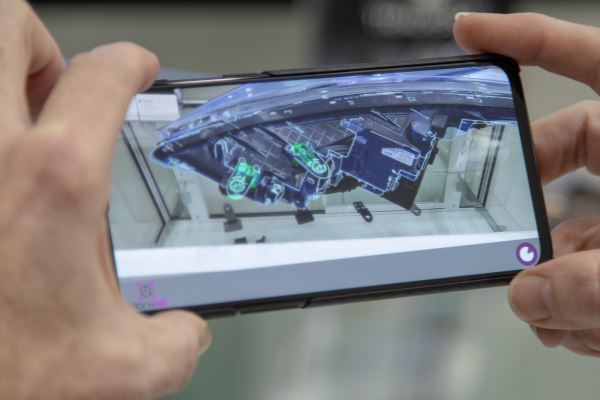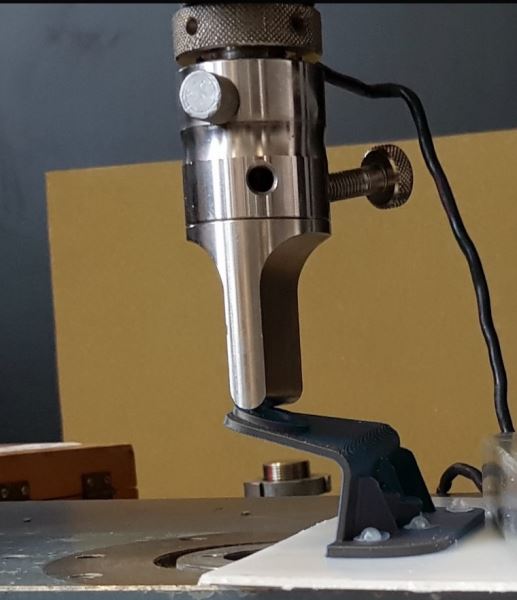Swinburne University of Technology has started testing a newly formulated 3D printing material that’s set to change the way auto repairs are carried out.
In a world first trial, the new polypropylene-based material will be used to 3D print replacement plastic bumper bar tabs and headlight lugs.
The research is being carried out in collaboration with industry partner Tradiebot Industries and with co-investment from the Innovative Manufacturing CRC (IMCRC).
And using state-of-the-art Augmented Reality (AR), Tradiebot has developed a new mobile app to enable collision repair technicians to perform quality control on repairs.
They can do this by overlaying an original CAD using the application via a smart phone, tablet or smart glasses.
The application will have the ability to scan broken plastic parts, generate a 3D model of the part and then enable the user to create, or select from a library, the required missing component.
This missing component will then be 3D printed using the new automotive compatible material. The developed replacement parts will be stored in a digital library of pre-designed parts, ready for download and 3D printing.
Increasing the number of parts being repaired
The advanced plastic material is compatible with automotive grade injection moulded plastic and will increase the number of parts being repaired and reused during the collision repair process, rather than these parts being sent to landfill or waste, due to missing tabs and lugs.
When ready for industry use, the solution will offer technicians a path to up-skill through learning to repair these parts and designing new replacement components for parts that would have previously required a brand-new replacement.
The new technology is the brainchild of Tradiebot CEO Mario Dimovski.
Mr Dimovski started his career as a 16-year-old plastic repair technician and has been involved with automotive plastic repair for the past 28 years.
He has been relentless in his quest to deliver not just this digital innovation, but also several other Industry 4.0 solutions in the fields of robotics, augmented reality and virtual reality.
Close working relationship with key partners
Forming close working relations with leading universities, government bodies and key industry collaboration partners over the last few years has been the key to Tradiebot’s success in leading innovation in the automotive repair industry.
“The new 3D printing material and the mobile app development marks a significant step towards the utilisation of new digital tools, additive manufacturing/3D printing and advanced materials in the collision repair industry,” Mr Dimovski said.
“Tradiebot has been leading the way in 3D printing innovations in the collision repair industry for the past four years and is very excited to bring to market such an innovative solution.”
Mobile application showing the use of Augmented Reality to perform quality control on a headlight to check positioning of the brackets
Enabling broken parts to be re-used
The in-house formulated polypropylene composite material developed by Swinburne materials scientist Dr Mostafa Nikzad and his team, will allow on demand replacement tabs to be printed and fuse welded by repair technicians on plastic car parts. This will enable the broken parts to be reused.
Dr Nikzad and his team had to create a material with the right bonding properties, strength and toughness required to meet automotive quality standards. Also, it had to possess the necessary characteristics to be 3D printed.
All while guaranteeing the compatibility with automotive grade injection moulded plastics.
The material choices were restricted to Polypropylene based (PP) composites to enable direct welding onto bumpers or headlight bases, as most of these are made from PP based composites.
Proud achievement
Dr Nikzad, who has been leading advanced material projects for the last 15 years, is proud of the work his team has achieved.
“It has been great working alongside an innovative project partner like Tradiebot,” Dr Nikzad said.
Dr Nikzad said in a world-first, the team is now planning a second phase of this project that involves embedding self-healing capabilities into the material.
In the research collaboration, Innovative Manufacturing CRC functions as a catalyst, co-investing in 3D printing and material innovation to create opportunities not just for Tradiebot and the automotive collision repair industry but for Australia’s broader manufacturing sector.
David Chuter, CEO and Managing Director at IMCRC, sees the progress of the research collaboration as an indication of the things to come.
“From day one Tradiebot and Swinburne University have been working hand-in-hand, embracing opportunities as well as challenges to drive progress and get the job done,” he said.
“Seeing them test new 3D printing materials that did not exist two years ago and explore digital technology to enhance the user experience is very rewarding.”
Tradiebot aims to have the material and mobile application available to the market early next year as the project moves into its final stage of commercialisation.


